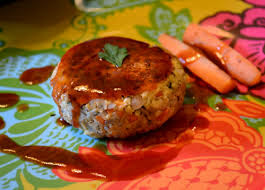
by Swami Adi Parashaktiananda | Oct 1, 2018 | Proper Diet
Ananda Mayi’s Teriyaki Tofu Cakes (Serves 4)
- 1lbs. block extra-firm Tofu, coarsely crumbled
- 1 cup of cooked Quinoa
- 1/2 cup cooked Oats
- 1/2 cup Carrot, finely chopped
- 2 Tbsp ground Flax and/or Chia seeds
- 2 Tbsp Sunflower Oil
- Salt and Black Pepper, to taste
Preheat oven to 400 degrees Fahrenheit.
Place all ingredients in a large bowl and thoroughly combine and mix together.
Shape a 1/4 cup of mixture into a ball and then slightly press into a flat patty about 1 inch thick. Place on a lightly oiled baking sheet and bake 10-15 min. Serve with teriyaki sauce.
Teriyaki sauce
- 4 Tbsp Soy Sauce, such as Tamari, or Bragg’s Liquid Aminos
- 2 Tbsp Sucanat (raw sugar)
- 1 Tbsp Arrowroot or Cornstarch dissolved in 3 Tbsp of cold water
Place soy sauce and sucanat (or unrefined sugar equivalent) in a saucepan over medium heat and stir until sugar dissolves, then add starch mixture and stir over heat until slightly thickened.
by Swami Adi Parashaktiananda | Sep 16, 2018 | Proper Diet
Food is essential to life. In the form of food only, we are able to absorb the 5 basic elements – ether, air, fire, water and earth – that will sustain the physical body. Food is also one of the three external sources of Prana or life force available to us; the other two are oxygen and sunlight. According to the Upanishads, the mind is composed of the most subtle vibrations of food. Therefore, Ayurveda, the science of life, points out that knowledge of proper diet/food-Aahar- is the main foundation for attaining optimum health and achieving balance and well-being. .
At the physical level, food is the only substance responsible for tissue buildup. The quality of our tissues as well as the ratio of wear and tear are mainly determined by the quality of food that we ingest. Ayurveda acknowledges two distinct metabolic processes where digestion occurs:
The first one takes place along the gastrointestinal tract starting in the tongue and ending in the colon where water absorption for feces formation occurs. The second stage deals with the assimilation or re-absorption of the food that is going to form the tissues in the liver. . These processes get affected with improper food taken through time. Agni, the digestive fire, weakens which in turn, prevents food from transforming effectively, paving the way for the accumulation of undigested matter or Ama. Disease appears as a result of Ama not being eliminated in due time. .
The involvement of Prana is expressed through Agni’s transformational functions of food in the form of Pitta along the g.i. tract in combination with the energies of movement and cohesion; that is the expression of the Doshas – Vata, Pitta and Kapha, the functional intelligence primarily behind the digestive processes and also everything in relationship to health and disease. .
Whatever we eat also creates an effect in the mind. Ayurveda does not classify food in terms of carbohydrates proteins, fats, etc. Food is rather classified like the gunas or qualities of the mind- Sattvic (pure, balancing), Rajasic (stimulating, agitating) and Tamasic (inert, dulling). What we eat is what we express. The quality of food that we feel drawn to ingest generally reflects the predominating guna of the mind. Since 80% of all diseases come from the mind and the mind is under the control of the gunas, food therapy is an essential component for healing the mind. .
Our inherent intelligence has programmed us to use food as therapy or medicine. Ayurveda offers a wide range of parameters, like the science of the 6 tastes, an extensive repertoire of spices and rich and diverse vegetarian food that will help promote digestion and sustain life at the physical level, provide strength stamina and enthusiasm at the energy level through regulation of Prana and Agni and balance of Doshas at the energy/vital level and control of mind and balance of emotions.
About Bharata Surya Javier Lopez (Bharata Surya) is a Sivananda Yoga Teacher and a certified Ayurveda Practitioner, Counselor, Pancha Karma specialist and Marma therapist trained in the US and India. For the last 15 years he has led a private practice and dealt in multiple corporate scenarios leading stress and pain management programs. He is actively providing marma therapy services at the Yoga Farm Ashram & SYVC Centers in California.
Please join us for the Food as Medicine: Ayurvedic Nutrition and Cooking Certificate Course. Bharata will share Ayurveda’s principles of six tastes and three constitutions to build recipes for restoring health and balance. Theory and hands-on practice learning to how to cook and the proper use of spices and herbs.
This course is part of a series of modules offered by the Sivananda Yoga Vedanta Organization in collaboration with Acharya David Frawley (Vamadeva).
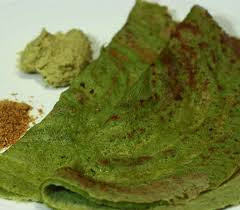
by Swami Adi Parashaktiananda | Jul 28, 2017 | Proper Diet
These thin pancakes make a wonderful snack with coconut chutney or served with some subji (cooked vegetables).
1/2 cup rice and 1/2 cup green moong dal
1/4 tsp salt, 1/4 tsp turmeric, 1/4 tsp hing(opt.)
1/2 tsp freshly grated ginger
Soak the rice and green moong dal in water the night before preparation, or at least 4 hours. Drain soaked rice/moong dal when ready. Blend with spices, freshly grated ginger, and enough water or buttermilk as needed to make a thick batter (similar to pancake batter).
Heat a non-stick griddle over medium heat. Pour about 1/2 cup of batter onto hot pan, making a thin round pancake by spreading the batter out in a spiral pattern starting from the center. Cook until golden brown, then flip and cook just the same. Drizzle with ghee and/or serve right away.
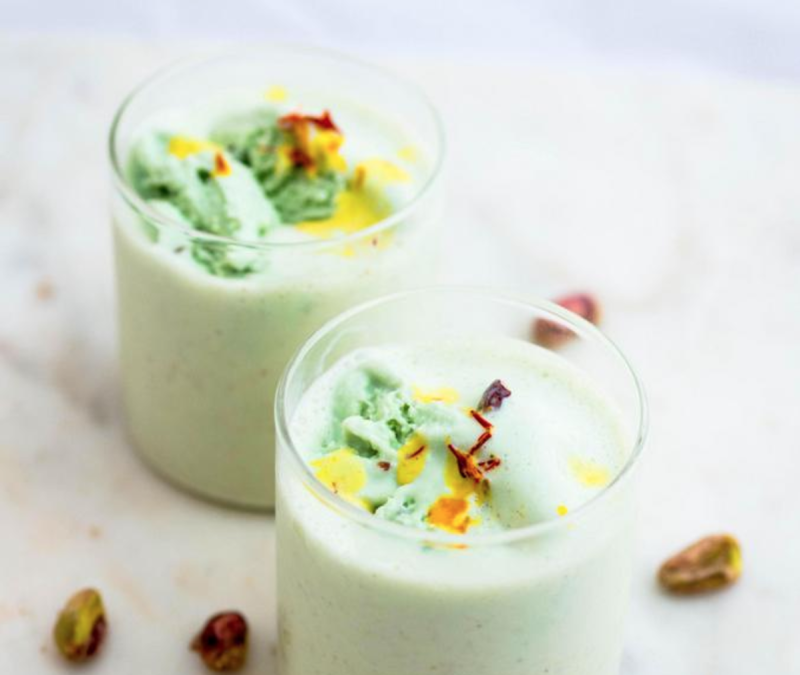
by Swami Adi Parashaktiananda | May 28, 2017 | Proper Diet
Power Drink
The Power Drink was first introduced to us by Dr. Kamlesh, reputed Ayurvedic Physician. This very nutritious drink is a real tonic. Dr. Kamlesh recommends taking it as a breakfast. Almonds are said to be excellent for the brain. Dry fruits provide you with plenty of energy for the morning.
5 almonds
1 big dry fig
1 or 2 dates; a few nuts (e.g. cashews or pistachios)
a few filaments of saffron
a few drops of rose water
The night before, soak the almonds in one bowl and the rest of the ingredients separately. In the morning peel the almonds; this will be made easier after the overnight soaking. Pit the dates and mix all the ingredients in the mixer, adding the saffron, the soaking water-and extra water if needed to adjust the consistency. (It should remain quite thick). Add a few drops of rose water before serving.
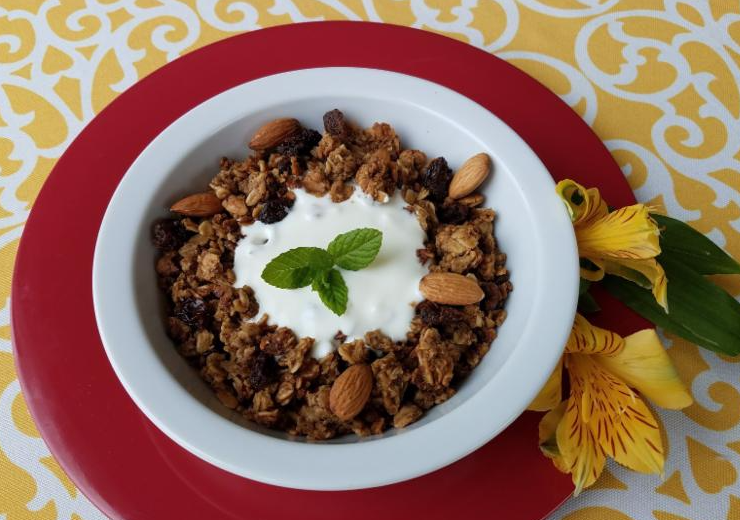
by Swami Adi Parashaktiananda | Apr 28, 2017 | Proper Diet
Easy Granola Recipe
Homemade granola is a great breakfast or anytime snack. Made with whole oats, granola is high in fiber and protein, in addition to being packed with important vitamins, minerals and antioxidants.
8 cups rolled oats
2 cups sucanat (or 1½ cups sugar)
4+ teaspoons of cinnamon (or other spice mix- optional)
2 cups water
1 cup sunflower oil
1 tablespoon vanilla extract
Preheat oven to 400°F. In a large bowl mix the first 3 dry ingredients. Add the remaining wet ingredients and mix thoroughly. Let sit for 10-15 minutes for the oats to absorb the liquid. Spread on 2 large baking sheets and place on middle racks in the oven. Bake for 20 minutes, remove and carefully toss/turn the granola. Bake for 15 minutes more and toss/turn again. Turn the oven off and let sit overnight to dry completely. Serve with milk, yogurt, nuts, seeds, fresh or dried fruit. Get creative and enjoy.
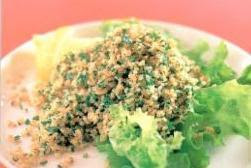
by Swami Adi Parashaktiananda | Apr 28, 2017 | Proper Diet
Tabbouleh is a wonderfully versatile dish that can be served as a fresh salad, side dish or appetizer served with hummus and pita bread or crackers.
1 cup bulgur wheat
½ cup boiling water
2 cups finely chopped parsley
2 cups finely chopped mint
Juice of 1 lemon
⅔ cup olive oil
Sea salt & pepper to taste
1 teaspoon cinnamon (or 1 peeled, finely chopped cucumber)
Lettuce leaves, to serve and lemon wedges, to garnish
Place the bulgur wheat in a large mixing bowl and pour the boiling water over it. Cover tightly and let sit for 30-40 minutes, until the water is absorbed and the grains are light and fluffy. Mix in the remaining ingredients, except for the lettuce leaves and lemon wedges. Serve Tabbouleh on lettuce leaves with lemon wedges for garnish.







